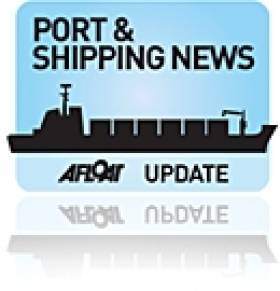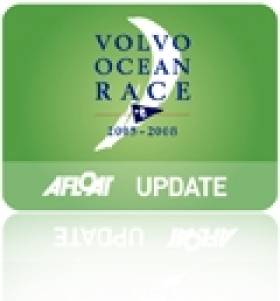Displaying items by tag: hull
Cracks in Hull Force Tanker Re-Routing to Belfast
#SHIPPING - The Irish Times reports that a tanker carrying hazardous cargo has been allowed to berth at Belfast Port after it reported a cracked hull off the north-west coast.
The 228-metre Germar Companion, which is is carrying 54,000 tonnes of vacuum gas oil, was on route from Rotterdam to New York when its crew discovered cracking in its upper deck some 25 miles off Tory Island.
The Air Corps and Naval Service were stood down after the cargo ship was granted permission to berth at Belfast, where its hull will be inspected.
Sanya Hull Damage First Photos Here!
#SANYA HULL DAMAGE – Team Sanya crew were driven back to Alicante to the team hotel they have called home for the past few weeks. For most, their families are still here. The damage to the boat is plain for all to see.
Team Sanya are weighing up the different options available to them which include repairing the boat in Spain or shipping her directly to Cape Town and carry out the repairs there. A final decision will be made later today.
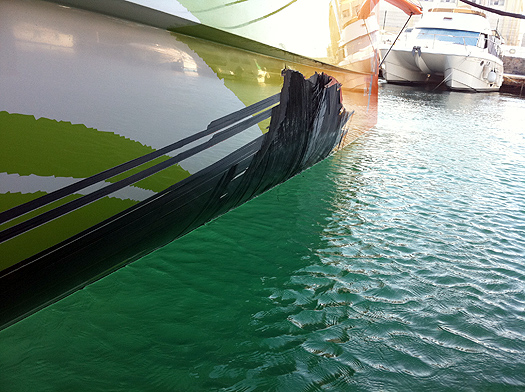
Above and below Sanya's smashed hull - Photo: Team Sanya
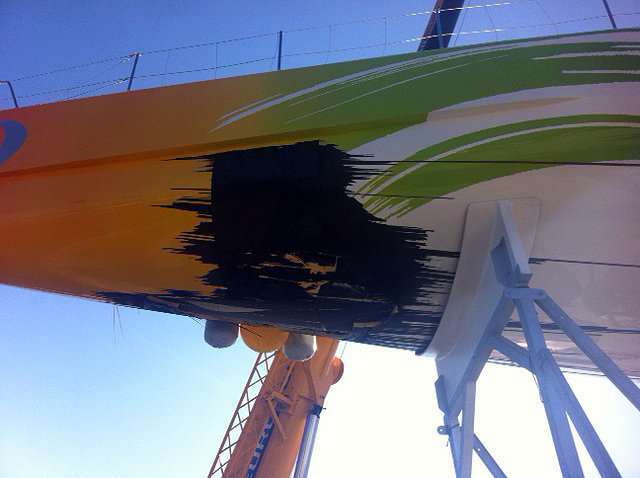
In a completely separate incident during a dramatic sail change yesterday, Team Sanya Bowman Andy Meiklejohn sustained an injury to his foot. He has now had the time to have that injury assessed and the hospital have indeed confirmed that he has broken his foot.
The hope is Andy's foot will have healed and be strong enough to be onboard for the 11th December start of Leg 2.
Reviewing The Top OK Dinghy Gear
News that the OK Sailing Dinghy is knocking on the door in Ireland means it might be a good time to take a look at the gear used by the top 10 sailors at the recent OK Dinghy World Championships in Largs, Scotland. It would be easy to assume that New Zealand has somewhat of a monopoly on fast OK Dinghies. Five of the hulls, six of the sails and all 10 of the masts were of New Zealand origin in some shape or form. Robert Deaves reports.
The event this year was mainly held in light and shifty winds, so for some sailors the value this of data is perhaps reduced, however it is true to say that the top sailors rose to the top as they normally do. There were no real surprises.
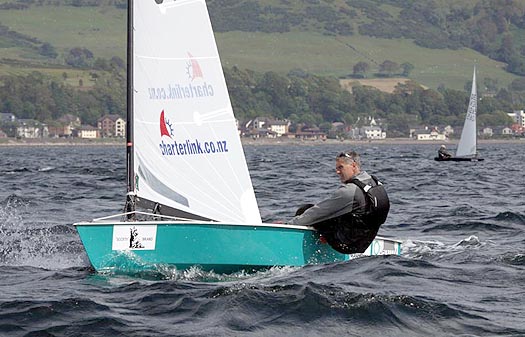
Alistair Deaves racing in Largs
To underline the competitiveness of this year's championship it is worth looking at the credentials of the top 10. Four were former World Champions, four were former Interdominion Champions, three were former Nordic Champions and eight were former National Champions. It was a top class field.
Hulls
The New Zealand made OK Dinghies from Icebreaker Boats NZ seem to be the boat of choice at the moment as many of the top sailors have chosen this builder. They have also won almost every major event of the past three years.
The Icebreaker shape goes back to the late 1960s when it was one of several designs from Alf Lock of Auckland. The fastest of his boats was used to take a mould and the Icebreaker came into existence. The boat has generally flat sections aft with minimal rocker and a fine entry to the bow. Upwind it tracks well and doesn't 'float' around as some of the fuller boats do. Offwind, while a fuller bowed boat would get into the plane slightly earlier, once the Icebreaker does, it has a faster top speed. In the light it is easy to handle and not as 'sticky' as some other designs.
Before 2008, Icebreaker hulls were really hard to get hold of outside New Zealand. The Kiwis didn't want the rest of the world to buy into their fast boats, and even though the mould passed through a number of hands, there was never much interest in exporting. But all that changed when Alistair Deaves took over the well used mould, refurbished it and to started to market the boat worldwide, no doubt helped by Karl Purdie (NZL) winning the 2008 World Championships in one of the first production boats.
However, according to Deaves, this is not the whole story. "The way the boat is constructed also plays a large part and Icebreaker Boats NZ has used modern computer design methods and materials to provide, what we think, is the best OK in the world. As much work as necessary is outsourced to ensure we get the best of everything."
"But of course the real reason why Icebreaker Boats NZ has such a good record is that we managed to sell to some of the best sailors, and perhaps that's the best endorsement of all. This is achieved by a policy of good quality and exceptional service, and customers often come back for new boats."
The moulding work for New Zealand Icebreakers is carried out in Auckland by Chris Brown of Performance Composites with the boats finished and marketed by Deaves through Icebreaker Boats NZ.
If it wasn't for the decline of the world economy, he says many more OK sailors would have chosen New Zealand made Icebreakers. "The import price was hiked out of reach for all but the rich and dedicated. In addition, some sailors pushed for copies of the Icebreaker to be made in Europe which has now led to three builders producing similar, but relatively cheaper copies."
Despite the crippling exchange rates some European buyers are still importing Icebreakers from New Zealand, though Deaves does admit that he has lost a lot of potential orders because of the complete nose dive in currency.
This season, like last season, Kiwi built Icebreakers have won most of the major events including the Interdominions, Spring Cup, Kiel Week, Warnemunde Week as well as many Nationals across Europe. It has also won five of the last seven world championships and last year's Europeans.
Ironically, though different NZ Icebreaker hulls won each and every race of this year's world championship, the highest place it achieved in the final overall standings was third. The championship was actually won by an Icebreaker copy, or Scolesbreaker, as it has been called, taken from Nick Craig's three times world championship winning New Zealand Icebreaker (though from a previous builder before Brown/Deaves) and built by Alex Scoles of UK based Idol Composites.
Though Craig sailed the most consistent series, by his own admission, he was not the fastest in the conditions at Largs. But, he said, "I am very pleased with my Scoles boat. Alex put in a lot of time ensuring the mould was perfectly fair, which has paid dividends with a fast and well-constructed boat that has a very long competitive life. It's nice to be able to focus on improving my rig whilst being 100% confident that my boat is fast."
Scoles commented, "It has been great for Idol Composites to have a world championship winning product and now my order book is bulging. The exchange rate has made Icebreaker Boats more expensive, but I don't think this had any significant impact on my orders so far."
In the last couple of years Idol Composites has sold OKs to the UK, Germany, Belgium, Ireland, Canada and Norway. This year it has had to take on extra staff and is looking to build more than 20 boats over the next 12 months. These are mainly for UK and Danish customers, though he also has potential orders from Sweden and Poland. Scoles also hopes to be able to ship a container full to Australia over the winter.
Idol composites offers what is considered the stiffest OK Dinghy available anywhere in the world. Everything is done in-house including the laminating, the painting and building the foils to maintain the high standards of build quality. As well as the standard gel coat finish, Idol Composites also offer 2-pack painted boats, which most of Scoles' customers opt for because of the saving in weight.
Scoles summed up his success, "It's a quality product together with a world title in a hull shape that OK sailors want." And that perhaps is the key. The Icebreaker shape is a shape from the past that everyone wants in the present.
However, all the other hulls in the top 10 are also old designs. The Hein is a German hull, with a fuller bow, the Rushworth is a copy of UK built Don O'Donnell hull from the 1970s and the Delfs copy is, as it suggests, a copy of the Swedish Delfs hull but built in Australia, with a full bow and very flat rocker that was very popular through the 1980s.
As ever there is nothing very new in the design of OK Dinghy hull shapes. As long as it is stiff, fair and down to weight, an old hull can be just as competitive as a new hull.
Masts
On an OK Dinghy, the mast is often considered the most important piece of kit. It is far more important that the hull or the sail, though of course the sail has to work with the mast to be any use. The move to carbon masts in 2004 sparked a lot of development worldwide, but in recent years the C-Tech mast from New Zealand has emerged as the most popular choice, principally after a lot of work from double world champion Karl Purdie (NZL). Even Craig has switched to a C-Tech after winning his first three titles with a Dutch built Celidh mast.
Out of any piece of kit on an OK Dinghy, C-Tech probably has the biggest market share. However, again, cost has become an issue as the exchange rate fell, opening up new development projects in Europe. But there is still some way to go on these.
Other masts in Largs included the UK built Aardvark and the Celidh.
Sails
Six out of the seven race wins in Largs were taken by sails built by Kiwis. Five of these were from Quantum Sails Potsdam, in Germany. The loft is run by Greg Wilcox, a former OK Dinghy world champion from New Zealand.
Wilcox, who himself finished fourth in Largs, explained, "Quantum Sails are individually made and matched to the sailor's weight, fitness level and, of course, mast bend. A lot of the other sails on the market are pre-made and the luff curve added last. This means there is really only one sail whereas we have a few different designs for different sailors."
"Our sails seem to have a bit of an edge when the conditions are quite varied. They seem to be very quick all round and especially downwind. I have worked with the top guys in the class like Karl Purdie and Thomas Hansson-Mild to develop the designs. They are both quite analytical and experienced and have provided very good feedback. I think this is obvious when they have won three of the last four worlds between them using these sails."
"Cloth choice is also very important however most sailmakers use Contender sailcloth which is very stable, light and reasonably durable. We try to get consistent cloth and work with our supplier towards this."
Craig used a UK built Speed sail, developed in conjunction with 2004 OK Dinghy World Champion Jim Hunt, but was never that happy with its light wind performance. Danish Green sails are very popular in Germany and Denmark and have been a key sailmaker for the class for decades. It's a similar story for Gale & Rimmington for Australia, though they tend to perform best in the windier conditions, something not experienced in Largs this year.
Other sails used in Largs include Pinnell & Bax from the UK, North from New Zealand, WB from Finland, Cicada from Germany and Linton from New Zealand.
Summary
Overall, whether by design or by choice, Kiwi knowledge and experience has produced some of the fastest combinations in the OK Dinghy in recent years and this trend looks set to continue. The main restriction for Europeans, and Americans, is the exchange rate, and before that returns to normality, if it ever does, the rest of the OK world needs to play catch up, or as in some cases, follow the same successful formula.
Table: Top 10 Gear at 2011 OK Dinghy World Championships
Shape Builder Sail Mast Board/rudder
1 Icebreaker copy Scoles Speed C-Tech Scoles
2 Hein. Hein Green C-Tech Hein
3 Icebreaker Icebreaker NZ Quantum C-Tech Jason King/KL
4 Icebreaker Icebreaker NZ Quantum C-Tech Deaves/C-Tech
5 Icebreaker Icebreaker NZ Linton/Quantum C-Tech Bumblebee
6 Rushworth Rushworth Quantum C-Tech Rushworth
7 Icebreaker Icebreaker NZ Green C-Tech Deaves
8 Icebreaker Icebreaker NZ Quantum C-Tech Deaves/C-Tech
9 Hein Hein Quantum C-Tech Hein
10 Jason King Delfs copy Gale & Rimmington C-Tech Jason King


























